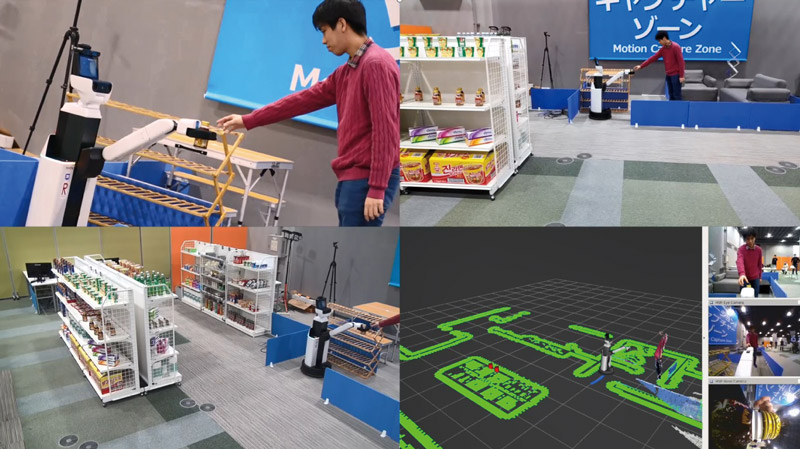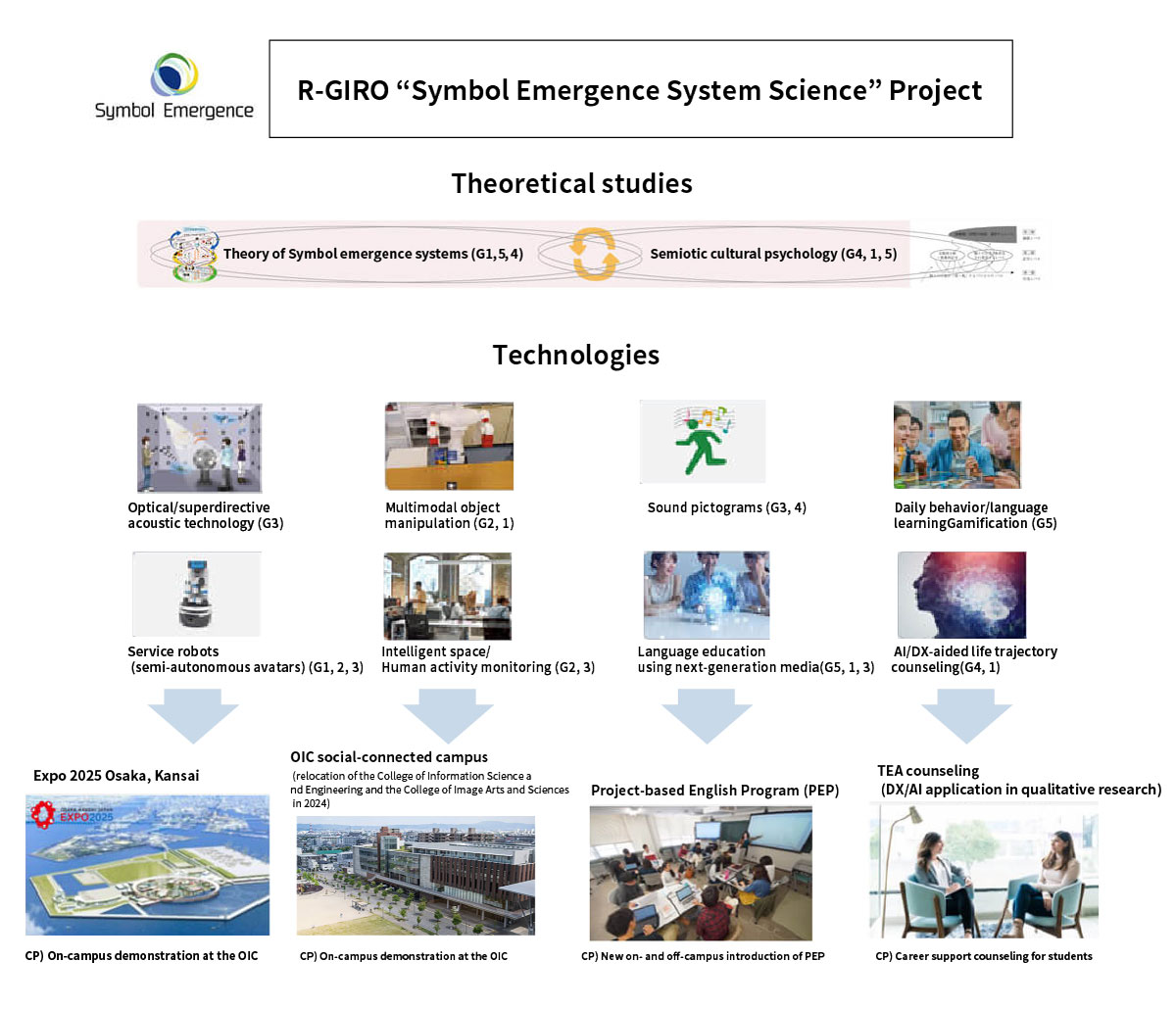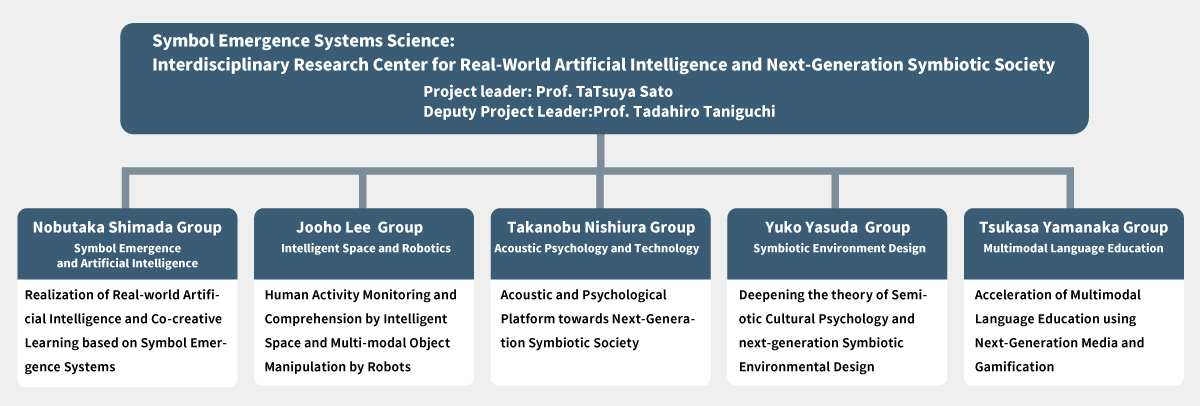Research AreaⅢ Overcoming the decline in the working-age populationSymbol Emergence Systems Science: Interdisciplinary Research Center for Real-World Artificial Intelligence and Next-Generation Symbiotic Society
Aiming to create a new academic field of "Symbol Emergence Systems Science" by integrating research on the development of real-world artificial intelligence and the design of next-generation symbiotic environments
Leaders
-
Project leaderTatsuya SatoProfessor, Department of Comprehensive Psychology, College of Comprehensive PsychologyProfile
-
Deputy Project LeaderTadahiro TaniguchiAffiliate Research Professo, Research Organization of Science and TechnologyProfile
-
Group leaderNobutaka ShimadaProfessor, Department of Information Science and Engineering, College of Information Science and EngineeringProfile
-
Group leaderLee JoohoProfessor, Department of Information Science and Engineering, College of Information Science and EngineeringProfile
-
Group leaderTakanobu NishiuraProfessor, Department of Information Science and Engineering, College of Information Science and EngineeringProfile
-
Group leaderYuko YasudaProfessor, Department of Comprehensive Psychology, College of Comprehensive PsychologyProfile
-
Group leaderTsukasa YamanakaProfessor, Department of Biotechnology,College of Life SciencesProfile
R-GIRO dedicated researcher
Extending the theory of symbol emergence systems not only to robotics but also to semiotic cultural psychology and philosophical semiotics
In the 2010s, the term "artificial intelligence" swept through society along with the development of deep learning. However, service robots that adapt to the real world and continuously act through communication with humans have not been created, and we are not fully enjoying their benefits in our living spaces. Moreover, technologies of artificial intelligence have not been utilized to enable us to enjoy diversity in society, taking into account the cultural and psychological aspects of human beings.
The "immaturity of real-world artificial intelligence" and the "underdevelopment of the next-generation symbiotic society" are related to the fact that human cognition and linguistic activities in the real world are meaning-making entities based on multimodal information and cultural context. This can be understood in a unified manner through the concept of "symbol emergence systems," which Professor Taniguchi has developed based on artificial intelligence and robotics research. Symbol emergence systems are a systemic view that represents the dynamics of the meaning of language and symbols that support human thought and communication.
Human meaning-making and language use are enabled through both physical interactions, such as how human babies form their perceptions based on multimodal information, and social interactions, influencing each other. Both are important in the real world, and robots must enter such human living spaces. It is difficult to extract meaning from words, connect it to one's own understanding and actions, and transform the use of words itself. For social implementation, we believe it is necessary to first clarify what it means for humans to learn language and culture.
Furthermore, the current situation where artificial intelligence technology has not been utilized to enable us to enjoy diversity in society is due to the gap between the nature of human cultural and habitual acts and the informational perspective in AI research. We believe that by integrating the theoretical and practical research accumulated in fields such as semiotic cultural psychology, linguistics, applied linguistics, and philosophical semiotics with symbol emergence systems science, we can lead to further advancement and accelerated social implementation.
Therefore, in this research project, we will work on the technological development of real-world artificial intelligence (i.e., service robots) that can acquire knowledge through interaction with humans in living spaces based on multimodal information in the highly uncertain real world, and support humans by considering context and habits. We will also engage in humanities research (i.e., next-generation symbiotic environment design) for allowing us to enjoy diversity in society using next-generation media that utilize AI/DX. Furthermore, to deeply integrate the academic theories that form the foundation of each, we aim to deepen the theories of symbol emergence systems, semiotic cultural psychology, and philosophical semiotics, and construct an interdisciplinary academic theory.
Simultaneously promoting the introduction of AI/DX technology in the studies in humanities and research on real-world artificial intelligence that coexists with humans
This project consists of five groups.
First, the Shimada group will clarify the mathematical models of the symbol emergence systems that support human semiotic communication, engineer their applications, and integrate artificial intelligence technology into service robotics. Specifically, we will study and develop the foundation for co-creative learning based on symbol emergence systems, where "humans and robots together create the symbol systems necessary for tasks and cooperation." We will also create a cognitive architecture and world model for real-world artificial intelligence that integrates modality information such as vision, hearing, and linguistic expressions with decision-making and motor control. In parallel, we will develop language understanding technology that considers human habits and culture for service robots, and intelligence technology that acquires and adapts symbolic knowledge in service environments. We will also develop a software platform aimed at streamlining the development of intelligence for various service robots.
The Lee group will develop " intelligent space" technology that observes the state of indoor and outdoor spaces and human behavior, and "robotics that works on humans and the environment" that fully utilizes the reality and physicality of robots. We will establish a method to construct a seamless, blind spot-free observation space with fixed and mobile sensors, and develop intelligence that integrates data obtained from sensors to extract human behavior and spatial information. Furthermore, we will develop algorithms for object recognition and human behavior analysis from the data obtained in the observation space, aiming to provide appropriate informational and physical support to users in the space. We will also work on procedure generation for tidying robots and the construction of a visuo-haptic integrated object manipulation model for robot hands.
The goal of the Nishiura group is to construct an "acoustic × psychology platform." We will study and develop next-generation robot hearing using pinspot information transmission that surpasses the human mouth, pinspot sound environment understanding that surpasses the human ear, and a visual microphone that converts object vibrations into sound waves based on image processing. We will also research sound design (sound pictograms) that become a world standard, where the meaning is clearly understood by anyone who hears it, and an audio quality evaluation model based on the auditory mechanism to realize robot-to-human communication through sound symbols without using words. By integrating approaches from both the technical and psychological aspects of sound, we will construct an "acoustic × psychology platform" and pursue next-generation robot communication that is friendly to humans.
The Yasuda group will use TEA (Trajectory Equifinality Approach), which is closely related to cultural psychology, to capture the concerns and choices made by mothers returning to work at turning points such as childrearing and by students considering their careers. We will construct a method for advanced life and career counseling using AI/DX, called "life trajectory counseling." By collecting and analyzing cases of consultations and concerns using TEA and visualizing them, we will build a system that enables counseling-like responses and aim for implementation through joint research with the Shimada group.
The main purpose of the Yamanaka group is to practice and present a model for next-generation university English education by utilizing symbol emergence systems science. Based on a language view that focuses on the pragmatic activities of humans to tenaciously live in the real world by making full use of their physicality and given abilities, we will develop multimodal language education by utilizing next-generation media and gamification in the project-based English program promoted by the members. We will also aim to advance the project-based English program by deepening the theoretical foundation and improving educational methods. We will actively interact with members involved in real-world artificial intelligence technology, pragmatically grasp the technical possibilities and limitations of AI/DX in English education while conducting research, and link it to social implementation and policy proposals for university education.
-

Robots that provide services through communication with humans in the real world
Contributing to society through the implementation of research results and becoming a project that symbolizes OIC
With the relocation of the College of Information Science and Engineering in 2024, almost all members of this project will gather at OIC, so we have a desire to establish a new research center. By realizing implementations in the SP LABs to be set up in the new building, on-campus implementations in project-based English education and student support counseling, and demonstrations of service robots at the EXPO 2025 Osaka in 2025, we aim to evolve into a project that represents OIC and create a new interdisciplinary research field of "Symbol Emergence Systems Science."
-

Research results envisaged in this project
077-561-3488 (9:00-17:30 on weekdays)
072-665-2570 (9:00-17:30 on weekdays)
075-465-8224 (9:00-17:30 on weekdays)
